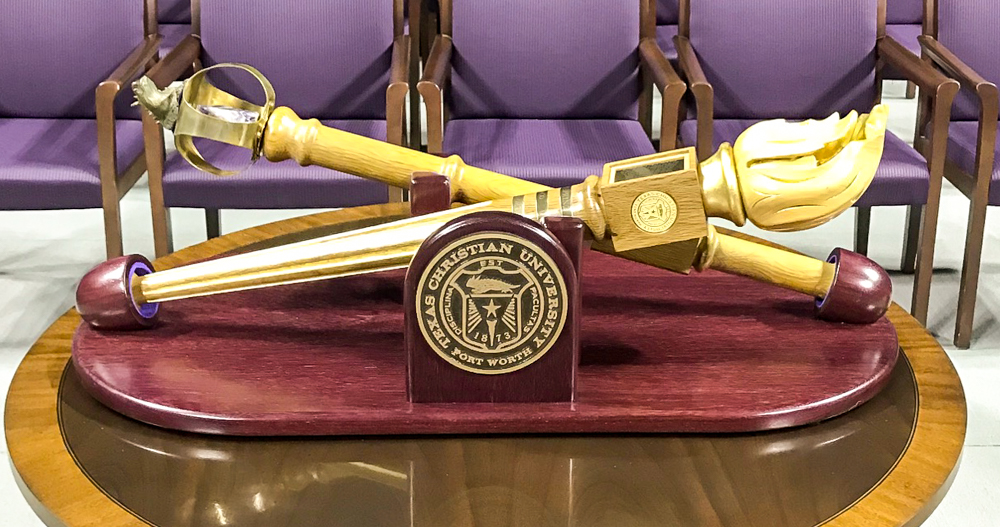Passing the Torch
Artist Raymond Huyge designed the Flame of Knowledge in honor of TCU’s sesquicentennial-year commencement ceremony.

The new Flame of Knowledge made its debut at the 2023 spring commencement and joins the mace for use in all commencement ceremonies. Courtesy of TCU Marketing and Communication | Amy Peterson
Passing the Torch
Artist Raymond Huyge designed the Flame of Knowledge in honor of TCU’s sesquicentennial-year commencement ceremony.
TCU’s Flame of Knowledge, a symbol for academic learning, wisdom and unity, is the university’s newest ceremonial element. The slim wooden sculpture, measuring 3 feet long, made its debut at the spring 2023 commencement ceremony, carried by Faculty Senate chair Jill Havens, a senior instructor in British literature and director of undergraduate studies and British and postcolonial studies.
The flame joins the mace for use in all commencement ceremonies. The mace, which represents the university’s administration, was introduced during Michael Ferrari’s inauguration as chancellor in 1999.

The first steps Raymond Huyge took in creating the Flame of Knowledge were to cut wood from a live oak and create a solar kiln to dry it for six months. Courtesy of Robert Huyge
Margaret Kelly, former executive director of community projects, suggested that TCU commission the flame in 2019.
“The sesquicentennial was our next big historic moment,” she said. “It was a perfect time to introduce the Flame of Knowledge.”
Woodworking artist Raymond Huyge, who previously installed lettering for TCU buildings including the King Family Commons, was tapped to create the flame.
Huyge cut wood from a live oak and created a solar kiln to dry it for six months. He carved a fluted handle from the wood and embedded a penny from 1873, the year TCU was established, into the bottom.
Atop the handle, a squared-off section holds gold university seals on two sides and plaques, bordered by inlays of legacy wood from a red oak on campus, on the other sides. One plaque, written by faculty members, explains the flame’s symbolic meaning, while the other bears TCU’s Native American land acknowledgement. The flame, carved from cypress, sits at the top.
“To me, a flame just brings people together,” Huyge said. “Overall, I’m very proud. This is a high-profile piece, and I’m honored to be the one to make it.”
When not in use, the Flame of Knowledge is on display in the Heritage Room in the Mary Couts Burnett Library, across from the mace.

Woodworking artist Raymond Huyge was picked to design the Flame of Knowledge based on previous work he had done on campus. Courtesy of Robert Huyge

Your comments are welcome
Comments
Related reading:
Features
A Storied Life
The ever-evolving Bob Schieffer reflects on the state of journalism and his first solo art exhibition.
Research + Discovery
Field Experience
Russell Mack, a strategic communication professor, brings his professional expertise to the classroom.
Research + Discovery
Deeper Compassion
Joe Hoyle’s capstone project examines the impact of empathy training on scuba volunteers.